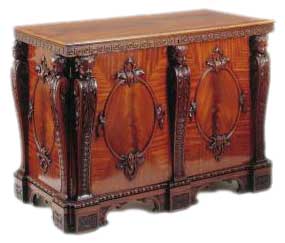The English Furniture Periods
The history of English antique furniture styles and periods in broad terms mirrors England's history generally. An island nation, somewhat cut off from the main currents of thought and design on the continental mainland by geography and historical circumstance, over time takes in greater influences from abroad both in human and intellectual form which produces fusions and resolvings of styles that are then carried across the world.
English Renaissance
At the earliest historic period that interests us here, early Tudor furniture, in some ways little distinguished from the preceding medieval era, we see the very beginnings of foreign influence on English furniture design as well as crucial advances in joinery methods. This period marks the beginning of the English renaissance furniture tradition.
Such advances and trends are continued in the late Tudor or Elizabethan furniture era.
Jacobean style furniture continues the penetration of renaissance ideas in design prevailing in France and Holland but is interrupted somewhat by the Cromwellian or Commonwealth interlude, a time in which the trend towards more decorative furniture was halted.
Baroque
The Restoration period marks the beginning of English baroque furniture, and the gradual replacement of oak wood by walnut and mahogany, and a great number of new models are developed, and then refined, through the following William & Mary and Queen Anne periods, the latter viewed by some as a particular high point in antique English furniture.
Rococo & Classical
For much of the early Georgian furniture period styles associated with the Queen Anne era remain persistent alongside the opulent Palladian style. Later in the mid Georgian period the decorative and playful French Rococo style of Thomas Chippendale leaves its heavy and lasting mark and in the late Georgian age we mark the coming of the leaner and more serious "Greek" neoclassical style.
The Georgian age also sees publications of the first pattern and design books by many now famous English furniture designers including Chippendale's "Director" and Hepplewhite's "Guide".
The ever present attraction of the classical civilisations of Greece and Rome, and now Egypt, reaches the peak of its influence in the time of Regency furniture in the early 19th century.
Eclectic
The Victorian age sees a perhaps confusing mishmash of revival styles and attempts at novelty in the early Victorian era and also sees a reaction against the mass production of furniture in the late Victorian period with the rise of the Arts & Crafts movement. Such trends are continued in Edwardian furniture when the craze for reproduction furniture reaches its peak.
Country & Colonial
Often standing outside the flow of great events in London, or simply behind them, there is the world of English country furniture making, craftsmen working on their own, or in very small workshops, producing furniture often in a rustic or primitive style, or often based on styles of yesteryear handed on down through the generations.
Also of interest is the history of British colonial furniture where the home grown traditions of Britain come into contact with Indian and tropical styles

